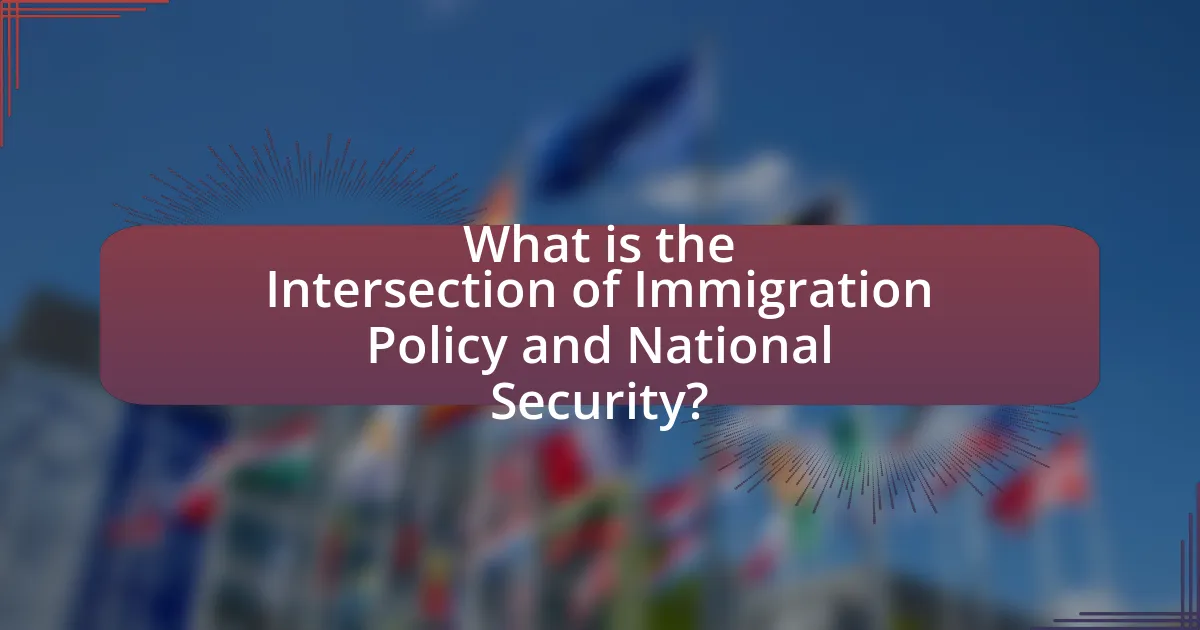The article examines the intersection of immigration policy and national security, highlighting how immigration regulations are implemented to protect national borders and public safety. It discusses the impact of immigration policies on national security, emphasizing the importance of vetting processes, border security, and enforcement of immigration laws. Key historical events, public perceptions, and legal challenges are explored to illustrate how these factors shape immigration policies. The article also addresses the role of technology and community engagement in enhancing security while balancing humanitarian concerns, ultimately outlining best practices for policymakers to create effective immigration frameworks that ensure national security.

What is the Intersection of Immigration Policy and National Security?
The intersection of immigration policy and national security involves the regulation of immigration to protect a nation’s borders and maintain public safety. Immigration policies are designed to control who enters a country, often incorporating security measures to prevent potential threats, such as terrorism or criminal activity. For instance, the U.S. Department of Homeland Security implements vetting processes for visa applicants to mitigate risks associated with foreign nationals. This relationship is underscored by events like the September 11 attacks, which prompted significant changes in immigration laws to enhance national security.
How do immigration policies impact national security?
Immigration policies significantly impact national security by regulating the flow of individuals into a country, which can either mitigate or exacerbate security risks. For instance, stringent immigration policies can enhance national security by allowing for thorough vetting processes that identify potential threats, as evidenced by the implementation of the U.S. Visa Waiver Program Improvement and Terrorist Travel Prevention Act of 2015, which aimed to strengthen screening of travelers from certain countries. Conversely, overly restrictive policies may lead to increased illegal immigration, creating challenges in monitoring and controlling who enters the country, potentially allowing individuals with malicious intent to exploit gaps in enforcement. Studies have shown that effective immigration policies can contribute to a safer environment by fostering cooperation between law enforcement and immigrant communities, thereby enhancing overall security.
What are the key components of immigration policy related to national security?
The key components of immigration policy related to national security include border security, vetting processes, and enforcement of immigration laws. Border security involves measures to prevent unauthorized entry and to monitor borders effectively, which is crucial for national safety. Vetting processes are designed to assess the backgrounds of immigrants and refugees to identify potential security threats, often involving biometric data and intelligence sharing. Enforcement of immigration laws ensures compliance with legal standards, deterring illegal immigration and enhancing national security. These components are supported by historical data indicating that robust immigration policies can reduce risks associated with terrorism and crime, as seen in various national security assessments conducted by government agencies.
How do these components influence national security measures?
Components such as immigration policy, border security, and intelligence sharing significantly influence national security measures by shaping how a nation manages threats and protects its citizens. Immigration policy determines who can enter a country, impacting the potential for both legal and illegal immigration, which can introduce security risks if not properly vetted. For instance, the 9/11 attacks highlighted vulnerabilities in immigration systems, leading to enhanced scrutiny and the implementation of stricter visa requirements. Border security measures, including physical barriers and surveillance technologies, directly affect the ability to control illegal crossings and monitor potential threats. Additionally, intelligence sharing among agencies and with international partners is crucial for identifying and mitigating risks associated with immigration, as evidenced by collaborative efforts in counter-terrorism that have thwarted numerous plots. These components collectively create a framework that balances the need for security with the principles of immigration, thereby directly influencing national security strategies.
Why is the relationship between immigration and national security significant?
The relationship between immigration and national security is significant because immigration policies directly impact a nation’s ability to manage threats and ensure public safety. Effective immigration control can prevent the entry of individuals who may pose security risks, such as terrorists or criminals, thereby safeguarding national interests. For instance, after the September 11 attacks in 2001, the U.S. government implemented stricter immigration measures to enhance national security, reflecting the direct correlation between immigration practices and the protection of citizens. This relationship underscores the necessity for comprehensive immigration policies that balance humanitarian concerns with the imperative of national security.
What historical events have shaped this relationship?
The relationship between immigration policy and national security has been shaped by several key historical events. The Immigration Act of 1924 established national quotas that restricted immigration based on nationality, reflecting a period of heightened xenophobia and the belief that certain groups posed security risks. Following World War II, the Cold War era prompted the McCarran-Walter Act of 1952, which allowed for the exclusion of individuals deemed subversive, further intertwining national security with immigration policy. The September 11 attacks in 2001 significantly transformed this relationship, leading to the implementation of the USA PATRIOT Act and increased scrutiny of immigrants, particularly from Muslim-majority countries, under the premise of national security. These events illustrate how immigration policy has often been influenced by perceived threats to national security, shaping the legal and social landscape of immigration in the United States.
How do public perceptions affect immigration policy and national security?
Public perceptions significantly influence immigration policy and national security by shaping political agendas and legislative actions. When the public expresses concerns about immigration, often driven by fears of crime or terrorism, policymakers may respond by enacting stricter immigration laws and enhancing border security measures. For instance, following the September 11 attacks, public anxiety about national security led to the implementation of the USA PATRIOT Act, which expanded surveillance and immigration enforcement. Additionally, surveys indicate that negative perceptions of immigrants correlate with support for policies that restrict immigration, such as the travel bans enacted during the Trump administration. These shifts in policy reflect the direct impact of public sentiment on national security strategies, demonstrating that immigration policy is often a response to the prevailing attitudes and fears within society.
What challenges arise at the intersection of immigration policy and national security?
Challenges at the intersection of immigration policy and national security include balancing the need for security with humanitarian obligations and economic interests. Immigration policies often aim to protect national security by screening individuals entering a country, yet these measures can lead to discrimination and human rights violations, as seen in policies that disproportionately affect certain nationalities. Additionally, the complexity of global migration patterns complicates the ability to effectively monitor and control borders, increasing the risk of illegal immigration and potential security threats. For instance, the 9/11 attacks highlighted vulnerabilities in immigration systems, prompting stricter regulations that sometimes hinder legitimate asylum seekers. Thus, the challenge lies in creating policies that ensure security without compromising ethical standards and international commitments.
What are the legal challenges faced by immigration policies?
Immigration policies face several legal challenges, primarily related to constitutional rights, statutory interpretation, and international obligations. Courts often scrutinize immigration laws for potential violations of due process rights, as seen in cases like Zadvydas v. Davis, where the Supreme Court ruled against indefinite detention of immigrants. Additionally, statutory challenges arise when policies conflict with existing immigration laws, leading to litigation that questions the authority of executive actions, such as those seen during the implementation of the Deferred Action for Childhood Arrivals (DACA) program. Furthermore, international obligations, including treaties on refugee protection, create legal hurdles when national security measures are perceived to infringe upon the rights of asylum seekers. These challenges highlight the complex interplay between immigration policy and legal frameworks that govern individual rights and international commitments.
How do security threats complicate immigration processes?
Security threats complicate immigration processes by necessitating more stringent vetting procedures for applicants. Governments implement extensive background checks, intelligence assessments, and security screenings to mitigate risks associated with terrorism and crime, which can lead to delays and increased scrutiny of applications. For instance, after the September 11 attacks, the U.S. significantly tightened immigration policies, resulting in longer processing times and more complex requirements for visa applicants. This heightened focus on security can create barriers for legitimate travelers and refugees, as the additional layers of scrutiny may inadvertently hinder their ability to obtain necessary documentation.

How do different countries approach the intersection of immigration policy and national security?
Different countries approach the intersection of immigration policy and national security through varying frameworks that balance security concerns with humanitarian obligations. For instance, the United States emphasizes border security and vetting processes, implementing measures such as the Enhanced Vetting Initiative to prevent potential threats from entering the country. In contrast, Canada adopts a more inclusive approach, focusing on refugee resettlement while maintaining security through thorough background checks, as evidenced by its commitment to resettle over 25,000 Syrian refugees in 2015, coupled with robust security screenings. Meanwhile, European nations like Germany have faced challenges in integrating large numbers of asylum seekers, leading to stricter immigration controls and policies aimed at enhancing national security, particularly after the 2015 migrant crisis. These varied approaches reflect each country’s unique socio-political context and security landscape, demonstrating the complex relationship between immigration policy and national security.
What are the varying strategies employed by different nations?
Different nations employ varying strategies in immigration policy to balance national security with humanitarian concerns. For instance, the United States utilizes a combination of border security measures, visa restrictions, and refugee vetting processes to mitigate potential security threats while allowing for legal immigration. In contrast, Canada emphasizes a points-based immigration system that prioritizes skilled workers, aiming to enhance economic growth while maintaining security through thorough background checks. Meanwhile, European countries like Germany have adopted a more open approach, particularly during the refugee crisis, focusing on integration policies to address security concerns while fulfilling humanitarian obligations. These strategies reflect each nation’s unique socio-political context and security priorities, demonstrating the diverse approaches to managing immigration in relation to national security.
How do cultural and political contexts influence these strategies?
Cultural and political contexts significantly influence immigration strategies by shaping public perception and policy priorities. For instance, in countries with a strong cultural emphasis on diversity, such as Canada, immigration policies tend to be more inclusive and supportive of multiculturalism, reflecting societal values that prioritize integration and acceptance. Conversely, in nations where political rhetoric emphasizes national security and cultural homogeneity, like the United States during certain administrations, immigration strategies may focus on restrictive measures and heightened scrutiny of immigrants, often justified by concerns over terrorism or economic competition. Historical events, such as the September 11 attacks, have also led to shifts in immigration policy that prioritize security over openness, demonstrating how political climates can directly impact the formulation and implementation of immigration strategies.
What lessons can be learned from international approaches?
International approaches to immigration policy and national security reveal the importance of balancing security measures with humanitarian considerations. Countries like Canada and Germany have successfully integrated refugee resettlement programs while maintaining robust security protocols, demonstrating that it is possible to protect national interests without compromising human rights. For instance, Germany’s 2015 refugee policy, which allowed over a million asylum seekers, was accompanied by extensive vetting processes that included background checks and integration programs, leading to a relatively low rate of security incidents among refugees. This illustrates that comprehensive immigration strategies can enhance national security while fostering social cohesion.
How do international agreements impact national security and immigration policy?
International agreements significantly influence national security and immigration policy by establishing frameworks for cooperation, information sharing, and legal standards among countries. These agreements, such as treaties on counter-terrorism, human trafficking, and refugee protection, create obligations that nations must adhere to, thereby shaping their domestic policies. For instance, the 1951 Refugee Convention obligates signatory countries to protect refugees, which directly impacts their immigration policies by requiring them to provide asylum and support to individuals fleeing persecution. Additionally, agreements like the Schengen Agreement facilitate free movement across borders while necessitating enhanced security measures to prevent illegal immigration and terrorism, thus intertwining national security with immigration control.
What role do treaties play in shaping immigration laws?
Treaties play a crucial role in shaping immigration laws by establishing binding agreements between countries that govern the movement of people across borders. These international agreements can set standards for the treatment of migrants, define the rights and responsibilities of signatory nations, and facilitate cooperation on issues such as border security and human trafficking. For example, the 1951 Refugee Convention and its 1967 Protocol outline the obligations of countries to protect refugees, influencing national immigration policies to align with international human rights standards. Additionally, bilateral treaties can streamline visa processes and enhance security measures, thereby directly impacting how immigration laws are formulated and enforced within participating countries.
How do global security concerns influence bilateral immigration agreements?
Global security concerns significantly influence bilateral immigration agreements by prompting countries to prioritize the screening and vetting of immigrants to mitigate risks associated with terrorism, crime, and other security threats. For instance, following the September 11 attacks in 2001, many nations revised their immigration policies to include stricter background checks and information sharing between governments, aiming to prevent individuals with potential security risks from entering their borders. This shift reflects a broader trend where countries negotiate immigration agreements that incorporate security measures, such as joint databases and intelligence sharing, to enhance national safety while managing immigration flows.

What are the future trends in immigration policy and national security?
Future trends in immigration policy and national security indicate a shift towards more stringent border controls and enhanced vetting processes. Governments are increasingly prioritizing national security by implementing advanced technologies such as biometric screening and artificial intelligence to assess potential threats from immigrants. For instance, the U.S. has expanded its use of data analytics to identify patterns that may indicate security risks, reflecting a broader global trend where countries are adopting similar measures to safeguard their borders. Additionally, there is a growing emphasis on international cooperation to address the root causes of migration, as seen in agreements between nations to manage migration flows and enhance security collaboratively. This approach aims to balance humanitarian concerns with the necessity of maintaining national security, as evidenced by recent policy shifts in Europe and North America.
How is technology changing the landscape of immigration and security?
Technology is significantly transforming immigration and security by enhancing border control, streamlining processing, and improving data analysis. Advanced surveillance systems, such as drones and biometric identification, enable authorities to monitor borders more effectively and identify potential threats in real-time. For instance, the use of facial recognition technology at airports has increased the efficiency of passenger screening, reducing wait times and improving security measures. Additionally, data analytics tools allow governments to process vast amounts of information related to immigration applications, helping to identify fraudulent claims and streamline decision-making. According to a report by the International Organization for Migration, the integration of technology in immigration systems has led to a 30% increase in processing efficiency in several countries.
What innovations are being implemented to enhance security in immigration processes?
Innovations being implemented to enhance security in immigration processes include advanced biometric identification systems, artificial intelligence for risk assessment, and blockchain technology for secure data management. Biometric systems, such as facial recognition and fingerprint scanning, improve identity verification, reducing the risk of fraud. AI algorithms analyze vast amounts of data to identify potential security threats, streamlining the vetting process. Additionally, blockchain technology ensures the integrity and security of immigration records, making them tamper-proof and easily accessible to authorized personnel. These innovations collectively strengthen the security framework of immigration processes, addressing vulnerabilities and enhancing overall national security.
How do data privacy concerns intersect with national security in immigration policy?
Data privacy concerns intersect with national security in immigration policy by creating a tension between the need for security measures and the protection of individual privacy rights. Governments often justify extensive data collection and surveillance of immigrants as necessary for national security, citing threats such as terrorism and illegal immigration. For instance, the USA PATRIOT Act expanded the government’s ability to monitor communications and access personal data, arguing that such measures are essential for preventing security threats. However, this can lead to potential violations of privacy rights, as seen in cases where data is collected without consent or oversight. Balancing these competing interests remains a critical challenge in shaping effective immigration policies that respect individual rights while ensuring national security.
What best practices can be adopted for balancing immigration and national security?
Best practices for balancing immigration and national security include implementing comprehensive vetting processes, enhancing information sharing among agencies, and fostering community engagement. Comprehensive vetting processes, such as thorough background checks and biometric data collection, ensure that individuals entering a country do not pose security risks. For instance, the U.S. Department of Homeland Security employs advanced screening technologies to assess applicants’ backgrounds effectively.
Enhancing information sharing among law enforcement, intelligence agencies, and immigration authorities allows for timely identification of potential threats. The integration of databases, such as the Terrorist Screening Database, facilitates better monitoring of individuals with suspicious backgrounds.
Fostering community engagement through outreach programs encourages cooperation between immigrant communities and law enforcement, which can lead to increased reporting of suspicious activities. Studies show that community trust can significantly improve public safety and national security outcomes. These practices collectively create a balanced approach that addresses both immigration needs and national security concerns.
How can policymakers create effective immigration frameworks that ensure security?
Policymakers can create effective immigration frameworks that ensure security by implementing comprehensive vetting processes for immigrants. These processes should include thorough background checks, biometric data collection, and collaboration with international law enforcement agencies to identify potential security threats. For instance, the U.S. Department of Homeland Security employs the Automated Biometric Identification System, which has successfully identified individuals with criminal backgrounds or ties to terrorism. Additionally, policymakers should establish clear pathways for legal immigration that prioritize skilled workers and those who can contribute positively to society, thereby reducing the incentive for illegal immigration. Research indicates that countries with structured immigration policies, such as Canada, have lower rates of crime among immigrants compared to those with less regulated systems.
What role does community engagement play in shaping effective policies?
Community engagement plays a crucial role in shaping effective policies by ensuring that the voices and needs of the community are incorporated into the decision-making process. Engaging with community members allows policymakers to gather diverse perspectives, which can lead to more informed and relevant policy outcomes. For instance, research by the National Civic League indicates that communities that actively participate in policy discussions tend to have higher satisfaction with government services and improved trust in public institutions. This engagement fosters transparency and accountability, ultimately resulting in policies that are more responsive to the actual needs of the population.





